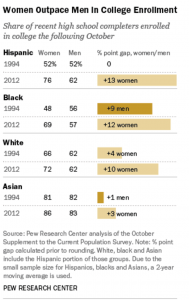Warning: Attempt to read property "ID" on null in /home/davidmor/eoop.davidmorgen.org/wp-content/plugins/subscribe-to-comments/subscribe-to-comments.php on line 194
Gender Gap Within College Tiers and Parental Income



 Commonly picked majors by women[/caption]
[caption id="attachment_475" align="alignnone" width="300"]
Commonly picked majors by women[/caption]
[caption id="attachment_475" align="alignnone" width="300"] Commonly picked majors by men[/caption]
Commonly picked majors by men[/caption] Widening Gender Gap for Higher Education Attainment
Across the board, Americans are more likely to graduate from high school, enroll in college, and obtain degrees than they were in the past. However, if we take a closer look, more women are now attending college than ever before and are outpacing men in college enrollment and graduation rates. According to Dr. Vedder, director of the Center for College Affordability and Productivity and professor at Ohio University, there are only 3 men for every 4 women that graduate from four-year colleges. There would be approximately 14% more college graduates each year, and over 2 million in over a decade, if men and women graduated from college in the same proportions. This gender gap is apparent across all ethnicities; however, it is more notable among blacks and Hispanics, where women graduates greatly outnumber men.
Since the Census Bureau started to collect information on higher education attainment, women are now more likely to obtain a bachelor’s degree than men. In 2015, 30.2% of women had a bachelor’s degree while 29.9% of men did. In 2005, only 26% of women had bachelor’s degree while 28.5% of men did. The reason for this increase is due to a rise in young women pursuing higher education. In females between the ages of 25-34, 37.5% of women have a bachelor’s degree or higher, whereas only 29.5% of men do. However, for people over the age of 65, only 20.3% of women compared to 30.6% of men have bachelor degrees or higher. This shift in gender indicates that as times are changing, more women than men are obtaining bachelor degrees.
Many have looked into factors that could have contributed to this growing gender disparity and concluded that gender and family-structure and socioeconomic status differences may have impacted the widening gender gap. According to a study by William Doherty, Brian Willoughby, and Jason Wilde, changes in family structures have led to the growing gender gap in higher education attainment. Both genders of children that grew up with stably married parents were equally likely to succeed at school, However, the absence of a father seemed to lead to less boys obtaining a college education. The researchers obtained longitudinal data on more than 15,000 people who were in 7th to 12th grade in the 1994-1995 school year from Add Health. The results illustrated that out of the participants whose fathers were present, 63.1% of men and 72.1% of women had some college education. From those who had an absent father, 49.2% of men and 61.3% of women had some college education. In addition, socioeconomic status can play a role in the increasing gender gap. As stated by Dr. Vedder, people who have had the most contact with the welfare state through public assistance policies, have also seen a decrease in males obtaining a college education. From these observations, it is likely that family structure and socioeconomic status impacts the widening gender disparity in higher education attainment. Other aspects that would be interesting to look at further would be to see the gender ratios at public and private universities and across different states.
Increasing Gender Gap in Colleges
 Although college enrollment rates have risen throughout the years, there is a growing gap between the enrollment rates of men and women. More women are now enrolling in colleges than men. This study conducted by Pew Research Center examines the gender gaps in college enrollment across 4 different ethnicities (Hispanic, black, white, and Asian) and compares data from 1994 and 2012. They found that in 1994, three out of four groups had more men enrolled in college than women. The only outlier was that among young white men and women who were enrolled in college immediately after graduation, young white women (66%) exceeded the men (62%) by 4%. By 2012, women enrolling in college immediately after graduating high school was greater than men across all groups.
Although college enrollment rates have risen throughout the years, there is a growing gap between the enrollment rates of men and women. More women are now enrolling in colleges than men. This study conducted by Pew Research Center examines the gender gaps in college enrollment across 4 different ethnicities (Hispanic, black, white, and Asian) and compares data from 1994 and 2012. They found that in 1994, three out of four groups had more men enrolled in college than women. The only outlier was that among young white men and women who were enrolled in college immediately after graduation, young white women (66%) exceeded the men (62%) by 4%. By 2012, women enrolling in college immediately after graduating high school was greater than men across all groups.
 I think that this is also an interesting aspect to look into concerning our question. Although it lacks the income levels, it includes gender differences in college enrollment between different ethnicities. It also examines possible reasons for the widening gender gap in college enrollments, with some scholars indicating that barriers to entering the labor market for women have been lower while others point to the higher incidence of disciplinary problems among boys in school as a factor. This study also takes note of the changes in demographics in the public school student population. Compared to 1994, there is an increase in diversity in public schools by 2012.
I think that this is also an interesting aspect to look into concerning our question. Although it lacks the income levels, it includes gender differences in college enrollment between different ethnicities. It also examines possible reasons for the widening gender gap in college enrollments, with some scholars indicating that barriers to entering the labor market for women have been lower while others point to the higher incidence of disciplinary problems among boys in school as a factor. This study also takes note of the changes in demographics in the public school student population. Compared to 1994, there is an increase in diversity in public schools by 2012.
Equality of Opportunity
 From looking at the data, I had expected that there would be more females attending college overall as you went down the income brackets; however, this was not the case. In most instances, both genders were about equally present at the colleges. In the highest income bracket, there were more females attending selectively private colleges than males, which differed from a NY Times article I had read that stated that at the highest income level, there were more males attending colleges than females. After looking at the data and seeing the trends, I think that in the future it would be interesting to look at other factors, such as race, and see how this affects the data.
From looking at the data, I had expected that there would be more females attending college overall as you went down the income brackets; however, this was not the case. In most instances, both genders were about equally present at the colleges. In the highest income bracket, there were more females attending selectively private colleges than males, which differed from a NY Times article I had read that stated that at the highest income level, there were more males attending colleges than females. After looking at the data and seeing the trends, I think that in the future it would be interesting to look at other factors, such as race, and see how this affects the data. 